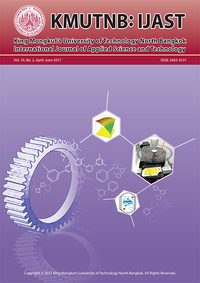Effect of Extraction Methods on Antibacterial Activity and Chemical Composition of Chinese Chives (Allium tuberosum Rottl. ex Spreng) Extract
Main Article Content
Abstract
The Bang-Phae organic vegetable grower community enterprise group, Ratchaburi province is one of the largest Chinese chives (Allium tuberosum Rottl. ex Spreng) growers in Thailand. However, not all of its Chinese chives meet the standard of retail markets and were sorted out. Producing Chinese chives extract is an alternative way to add value to the rejected produces. The Chinese chives essential oil contains many new and known bioactive
compounds. Therefore, this experiment was aimed to study the antibacterial activity of Chinese chives extracts using 17 difference extraction conditions (Steam distillation for 1.0, 2.0, 2.5, 3.0 h; Ohmic pretreatment followed by steam distillation for 1.0, 2.0, 2.5, 3.0 h; 95% ethanol, hexane, soy bean oil extraction using dried, fresh and frozen Chinese chives) against 6 different pathogenic bacterium (Escherichia coli ATCC25822, Salmonella
enterica Typhimurium U302, S. enterica Enteritidis, S. enterica 4,5,12:i (human) US clone, Bacillus cereus and Listeria monocytogenes 10403S). The disc agar diffusion method with 3 different concentrations of extracts (25, 50, 75 mg/mL) was used to evaluate the antibacterial activity. The results showed that different extraction conditions significantly affected the antibacterial activity. The higher extract concentration resulted in the better antibacterial activity. This finding indicated that both extraction condition and extract concentration significantly influence antibacterial activity. The extracts obtained from thermal extraction seem to have higher antibacterial activity than the ones obtained from cold extraction. The extract obtained from steam distillation for 2.5 h resulted in the highest antibacterial activity; 75 mg/mL of the extract caused 0.688 ±0.023 cm clear zone against B. cereus and L. monocytogenes 10403S. The chemical composition profile using GC-MS showed high percentage of organosulfide volatile compounds in thermally extracted Chinese chives. Therefore, the organosulfide volatile compounds might be responsible for effective bacteria inhibition.


